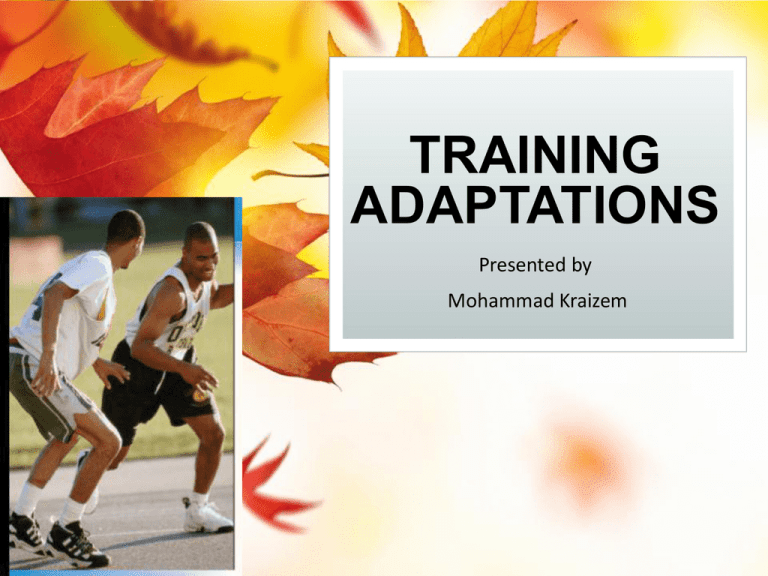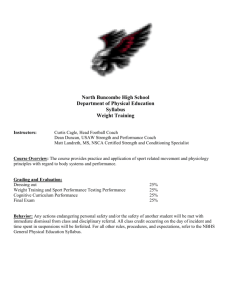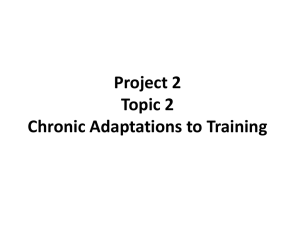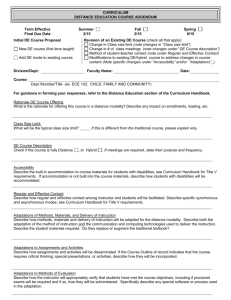TRAINING ADAPTATIONS
advertisement

TRAINING ADAPTATIONS Presented by Mohammad Kraizem OBJECTIVES Describe and analyze physiological responses to anaerobic training Describe and analyze physiological responses to aerobic training Recognize the causes, signs, symptoms, and effects of overtraining and detraining THERE ARE 2 TYPES OF PHYSIOLOGICAL RESPONSES TO EXERCISE: 1. Immediate short-term responses (acute responses) – last for the duration of the exercise and a short time afterwards. 2. Long-term responses (chronic adaptations) – the body adapts over time to an exercise program. Known as the training effect and will last until training ceases. Upon cessation, de-training (reversibility) will occur- revert back to pre-conditioned state. CHRONIC TRAINING ADAPTATIONS These depend on: The type of training undertaken. Aerobic training – 6-12 weeks at systems and tissue level. The frequency, duration and intensity of the training. The individual’s capacity and hereditary factors. SAID PRINCIPLE- SPECIFIC, ADAPTATION, IMPOSED, DEMANDS “the particular activity we are involved in will encourage our bodies to adapt in specific ways to meet that activity’s specific demands. Adaptation- long term physiological change in response to training loads that allows the body to meet new demands. CHRONIC ADAPTATIONS TO AEROBIC/ENDURANCE TRAINING A). CARDIOVASCULAR ADAPTATIONS TO AEROBIC TRAINING : designed to bring about more efficient delivery of o2 to the working muscle. CV adaptations are good b/c they decrease risk of developing CV disease and other health related issues. -best developed through continuous, Fartlek and longer interval type training. FARTLEK which means "speed play" in Swedish, is a training method that blends continuous training with interval training. The variable intensity and continuous nature of the exercise places stress on both the aerobic and anaerobic systems. It differs from traditional interval training in that it is unstructured; intensity and/or speed varies, as the athlete wishes. Most fartlek sessions last a minimum of 45 minutes and can vary from aerobic walking to anaerobic sprinting. Fartlek training is generally associated with running, but can include almost any kind of exercise. ADAPTATIONS INCLUDE: 1.Cardiac Hypertrophy; like skeletal muscle the heart will hypertrophy if exercised (enlarge). Left ventricle chamber will enlarge in volume and thus significantly increase SV (stroke volume). Aerobic. 2.Increase capillarisation of heart; develops an increased coronary blood supply. Exercise or training regularly over an extended period of time (3 times per week for 6- 8 weeks) leads to the development of long-term or chronic adaptations to training. Evidence of these adaptations can occur at various stages Once achieved, these adaptations are retrained unless training ceases. Upon cessation, the body will gradually revert to its pre-training condition (de-training). CAPILLARISATION Capillarisation is a muscle growing process where the blood vessels surrounding a muscle fiber (cell) increase in number. It results from performing high reps during workout as well as aerobic exercise. Capillarisation can help with the recovery process of the muscles as greater blood flows to muscles imply more oxygen and nutrients can travel to the muscles. UNLIKE ACUTE RESPONSES TO EXERCISES, CHRONIC ADAPTATIONS TO TRAINING VARY GREATLY AND ARE DEPENDANT UPON: Type and method of training undertaken – aerobic vs anaerobic training. Chronic responses are very specific to the type of training performed. The frequency, duration and intensity of the training undertaken – the greater these things, the more pronounced the adaptations The individual’s capacities and hereditary factors (genetic make-up) CHRONIC ADAPTATIONS TO AEROBIC (ENDURANCE) TRAINING: Minimum period is 6 weeks More evident over 12 weeks Adaptations occur at both tissue and system levels. CARDIORESPIRATORY ADAPTATIONS TO AEROBIC (ENDURANCE) TRAINING Chronic cardio-respiratory adaptations are primarily designed for more efficient delivery of larger quantities of oxygen to working muscles. They decrease cardiovascular disease (CVD)and other health-related illnesses. Cardio-respiratory adaptations are best developed through continuous, fartlek and longer interval type training. CARDIOVASCULAR ADAPTATIONS: Cardiac hypertrophy (increased ventricular volume): Enlargement of the heart muscle itself Increase in size and volume of the ventricular chambers, particularly the left ventricle occurs. Significantly increases stroke volume INCREASED CAPILLARISATION OF THE HEART MUSCLE: Increase in capillarisation of the heart muscle itself (Increase in capillary density and blood flow to the heart muscle) Increased supply of blood and oxygen allows the heart to beat more strongly and efficiently during rest and exercise Coronary protective benefit (therefore decreased risk of heart attack) INCREASED STROKE VOLUME OF THE HEART: Heart ejects a greater volume of blood with each beat Stroke volume is greater at rest, during submax and max workloads for a trained athlete compared to an untrained person Eg. Average stroke volume at rest: Untrained male - 70-80millilitres/beat, Trained male endurance athlete - 100millilitres/beat or more. DURING MAXIMAL EXERCISE: Untrained person – 110 millilitres/beat Trained person – 130 millilitres/beat Elite endurance athletes – 190 millilitres/beat Trained and untrained females have lower stroke volumes than their male counterparts under all exercise conditions, mainly due to a smaller heart size LOWER RESTING HEART RATE: The amount of oxygen required by an individual at rest does not alter as a result of their training status. At rest, it takes about 5 litres of blood per minute (cardiac output) to circulate around the body to supply the required amount of oxygen to the body cells Cardiac output (Q) is equal to stroke volume (SV) multiplied by heart rate (HR). Q = SV x HR However, if an individual has developed a greater stroke volume, the heart does not have to beat as frequently to supply the required blood flow Eg. Before training: Q = SV x HR 5L/min = 70 mL/beat x 71 beats/min After training: Q = SV x HR 5L/min = 100 mL/beat x 50 beats/min This is why resting heart rate is a useful indicator of aerobic fitness. Lower resting heart rate – greater level of aerobic fitness · Elite – 35bpm (marathon runners, triathletes, distance swimmers) · Average adult male – 70bpm THANK YOU ALL






